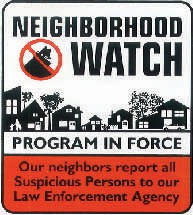Neighborhood Watch
|
PART OF THE CITY OF PALO ALTO EMERGENCY SERVICE VOLUNTEER (ESV) PROGRAM
|
Neighborhood Watch Information
Block Watch, Apartment Watch, Town Watch, Building Watch or Crime Watch. Whatever the name, it’s one of the most effective and least costly ways to prevent crime, reduce fear and build community. Neighborhood Watch fights the isolation that crime creates and feeds upon. It forges bonds among area residents, helps reduce burglaries and robberies, and improves relations between police and the communities they serve.
Why Neighborhood Watch?
- It works. Dramatic decreases in burglary and related offenses are reported by law enforcement professionals in communities with active Watch programs.
- Today’s transient society produces communities that are less personal. Many families have two working parents and children involved in many activities that keep them away from home. An empty house in a neighborhood where none of the neighbors know the owner is a prime target for crime.
- Neighborhood Watch also helps build pride and serves as a springboard for efforts that address other community concerns such as recreation for youth, childcare, and affordable housing.
How to start a Neighborhood Watch?
A motivated individual, a few concerned residents, a community organization, or a law enforcement agency can spearhead the efforts to establish a Watch. Together we can:
- Organize a small planning committee of neighbors to discuss needs, the level of interest, and possible community involvement.
- Contact Palo Alto Emergency Services or the Palo Alto Police Department for help in home security and crime
- Recruit a Block Preparedness Coordinator for your block. who is responsible for relaying information to members
- Hold an initial meeting to gauge neighbors’ interest, establish the purpose of the program, and begin to identify issues that need to be addressed.
- Recruit members, keep up to date information on new residents and make special efforts to involve the elderly, working parents, and young
- Work with local government and law enforcement to put up Neighborhood Watch signs, usually after 50% of all households are actively involved in your Neighborhood Watch
- Include a Safe House where kids can go in case of an emergency in your neighborhood.
- Include Emergency Preparedness Personal Preparedness activities
Who can be involved?
Any neighborhood resident can join, young and old, single and married, renter and homeowner. The busiest people can belong to a Neighborhood Watch and they can keep an eye out for neighbors as they come and go.
I live in an apartment building. Can I start a Neighborhood Watch?
Yes. Watch Groups can be formed around any geographical unit: a block, apartment building, townhouse complex, park, business area, public housing complex, office building or marina.
What does a Neighborhood watch do?
A Neighborhood Watch is neighbors helping neighbors. They are extra eyes and ears for reporting crime and helping neighbors. Members meet their neighbors, learn how to make their homes more secure, watch out for each other and the neighborhood, and report activity that raises their suspicions to the police or sheriff.
What are the major components of a Neighborhood Watch Program?
- Community Meetings. These should be set up on a regular basis such as monthly, bi‑monthly, or every other month.
- This can be as simple as a weekly flier posted on community announcement boards, a newsletter that updates neighbors on the progress of the program, or a neighborhood electronic bulletin board.
- Special Events. These are crucial to keep the program going and growing. Host talks or seminars that focus on current issues such as hate or bias-motivated violence, crime in schools, teenage alcohol and other drug abuse, or domestic violence. Adopt a park or school playground and paint over graffiti. Sponsor a block party, holiday dinner, or sporting event that will provide neighbors a chance to get to know each other.
- Other Aspects of Community Safety. For instance, start a block parent program to help children in emergency situations.
What are my responsibilities as a Neighborhood Watch member?
- Be alert! Know your neighbors and watch out for each other.
- Report suspicious activities and crimes to 911 and your neighbors.
- Learn how you can make yourself and your community safer.
What kind of activity should I be on the lookout for?
• Someone screaming or shouting for help.
• Someone looking in windows of houses or cars.
• Property being taken out of houses where no one is at home or from closed businesses.
• Cars, vans or trucks moving slowly with no apparent destination or without lights.
• Anyone being forced into a vehicle.
• A stranger in a car stopping to talk to a child.
Report these incidents to the police or sheriff. Talk about concerns and problems with your neighbors.
How should I report these incidents?
• Call 911 or your local emergency number.
• Give your name and address.
• Explain what happened.
• Briefly describe the suspect: sex, race, age, height, weight, hair color, clothing, distinctive characteristics such as a beard, mustache, scars or accent.
• Describe the vehicle if one was involved: color, make, model, year, license plate, and special features such as stickers.
—————–
Palo Alto Emergency Services Department
250 Hamilton Avenue Palo Alto, CA 94301
Main Phone: 650-617-3197
Emergency: 911
Website: www.cityofpaloalto.org
Free Crime Statistics Online: Website: www.communitycrimemap.com

